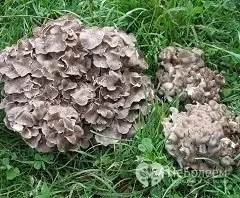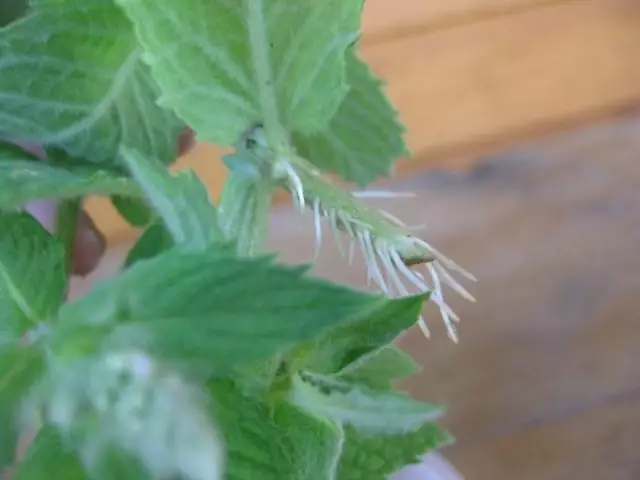- Author Rachel Wainwright [email protected].
- Public 2023-12-15 07:39.
- Last modified 2025-11-02 20:14.
Curly griffin
Instructions for use:
- 1. Chemical composition
- 2. Useful properties
- 3. Indications for use
- 4. Contraindications
- 5. Home remedies

Curly griffin (maitake, meitake, ram mushroom, oak tree polypil, leafy tinder fungus, dancing mushroom, geisha mushroom, ram's head, wood hen), lat. The name Grifola frondosa is the largest edible tinder fungus. Its fruit body consists of numerous interconnected spade-shaped or semicircular, thin, flat caps with a diameter of 0.5-10 cm on repeatedly branching legs, merging into a common base. The mushroom can be up to 80 cm in diameter and weigh up to 10 kg. The color of the fruit body is from grayish-brown to yellowish-gray, the spore powder with which the fungus propagates is white.
The mushroom is attached by the fruiting body or lateral legs to old trees, stumps, logs. Under natural conditions, it is rare and does not grow annually, but grows quickly, causing white rot. Griffin is cultivated in mushroom farms, mainly in Southeast Asia. On the territory of Russia, it occurs in the west of the Smolensk region in deciduous forests from late June to late September at the base of old oaks, less often maples, and in the south - chestnuts and beeches. Listed in the Red Book.
Chemical composition
The fruiting body of curly griffins contains: polysaccharides (lentinan, grifolan, beta-D-glucan), flavonoids, triterpenes, steroids, saponins, amino acids, chitin, phytoncides, niacin, vitamins of groups B and D, minerals (magnesium, calcium, potassium, selenium, zinc, etc.).
Beneficial features
The organic polysaccharides of the d-fraction, especially the beta-glucan grifolan, have a therapeutic effect on the body. Thanks to them, the mushroom has a strong antitumor and antiviral activity, including against the human immunodeficiency virus (HIV), which was confirmed by the results of scientific research. The active components of the fungus inhibit the development and growth of many neoplasms, stimulate the activity of T-lymphocytes, including CD4 cells.
The polysaccharides contained in curly griffin contribute to the normalization of cholesterol and sugar levels in the blood.
In folk medicine, the properties of the plant are highly valued: bactericidal, antiparasitic, detoxifying, strengthening the cardiovascular system, improving blood circulation and increasing immunity.
Medicines and folk remedies based on griffols are distinguished by the absence of toxicity and high tolerance.
Indications for use
- tumors;
- viral diseases, including HIV;
- arterial hypertension;
- diabetes;
- high cholesterol levels, atherosclerosis;
- obesity (for weight loss and control);
- hepatitis B and C;
- overwork, chronic fatigue syndrome;
- headaches, migraines;
- skin diseases, including acne;
- bronchopulmonary diseases, tuberculosis;
- burns, skin ulceration, hard-to-heal wounds;
- diseases of the digestive system, indigestion, constipation, flatulence;
- parasitic invasions.
Contraindications
Griffola curly is practically harmless, in case of overeating, it can cause stomach upset, since it contains chitin in large quantities.
You should not pick the mushroom near industrial enterprises, big cities, busy highways (due to the property of mushrooms to absorb and accumulate harmful substances from the environment).
During pregnancy and during breastfeeding, it is not recommended to use drugs based on curly griffins, since there is not enough information about the safety and effectiveness of their use during this period.
Home remedies from Grifole curly
- powder (mushrooms are dried, crushed and abraded) is used as an antiseptic for external use for difficult healing wounds, ulcers, burns and for the treatment of certain skin diseases;
- water decoction is an effective anti-inflammatory agent and is recommended for tuberculosis, bronchopulmonary diseases, headaches, chronic fatigue and helminthic invasions;
- tincture of grifola is used for diseases of the digestive system, hypertension, indigestion, flatulence and constipation;
- ointment from griffols is used to cleanse the skin of the face, rejuvenate and treat acne.
Information about the drug is generalized, provided for informational purposes only and does not replace the official instructions. Self-medication is hazardous to health!






